



Entering a Competition
About three weeks before a competition your teacher will give you an entry form. You will be required to tick which dances your child is going to enter. You will only be ticking the beginner section, and at first only the Jig (hop & hop) and may be the Reel (over 2,3) this will cost you $4 - $5 per dance. Your teacher may have to sign the bottom and check your choice and then you post it off with a cheque.
Keep a copy of the entry form as it has the address of the competition and what dances your child has entered. The timings for each age group will be announced at the studio ( or a notice on the wall) two or three days before the competition. Little beginners are most likely to be on Sunday morning but this can change.
|
For your first competition you may not have an Irish Dancing Dress but beginners donít have to have one straight away. A party dress or a tartan skirt and white blouse will do, you might like to add a soft shawl caught at the shoulder and opposite waist. Later on you may wish to hire a dress from the Studio for an annual fee or buy a used dress. Used dresses have a good resale value and buyers can be found when your child outgrows it. If you live in Sydney, Pauline from Celtic Originssells second hand dresses on consignment from her shop in Penrith. (take your polaroid with you to show the teacher the dress you're interested in). |
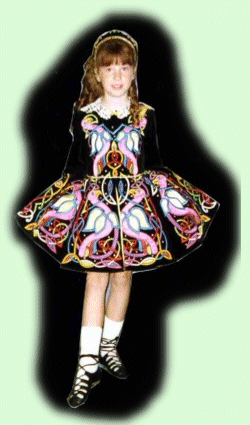
|
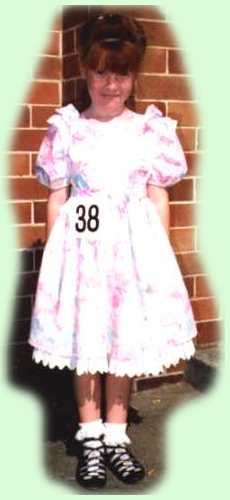
|
|
Intermediate -Open Level Dress |
|
|
A Party Dress for a Beginners' Comp |
Don't forget the knickers ... Knickers which match the underskirt colour are worn when dancing. Many mothers make smocks for the children to wear over the dress as they may be wearing it for a few hours. Food is almost always on sale at competitions and the smocks cut down on dry-cleaning bills.
Boys wear good dark trousers, not too loose, so as not to disguise the leg movements, and with a bit of stretch to them for ease of movement. White or coloured long sleeve collared shirt, with a bit of fullness.
Tie/bowtie - check with your teacher (some have a preference for one or the other, or prefer no tie). Maybe a vest with celtic motif - to stand out from the crowd. Some boys wear celtic belts (like cummerbunds) instead of vests. The boys have an advantage in smaller local comps in that they are unusual enough to be noticed anyway. You will also see some boys in kilts and blazers.
Boys' Shoes - soft shoes like boys jazz shoes - lace up, with small heel. Later in higher grades, boys wear soft shoes with a heel that they can click together like hard shoe dancing.
Making Your Own Dress
Second hand dresses range in price from $200 to $1000 depending on age and condition. You can make your own if you're talented and there is a Simplicity Pattern 9131 available. (But please don't use the mega-shamrock design as per the cover) Take a look at the Irish Dancing Dress Pattern. Materials to use are gabardine for beginners and Velvet/Gabardine or Thai silk and Lace for the Open Grade Dancers. The dresses use very thick stiffening to get that traditional look. And the embroidery designs can be purchased from America from the Irish Dancers' Catalogue. You might be able to find some local talent to help you with the designs, but the embroidery is done before the dress is assembled. Always seek the advice of your teacher before you make costly investments. If you are too chicken to make your own.. try a professional. But be prepared to join a long queue, give as much lead time as you can. Irish Dancing Dress Makers in Australia
|
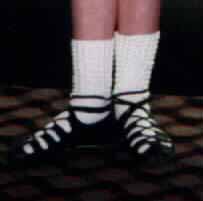
|
A Beginner will only be using soft shoes at first (girls- black slippers with criss cross laces. Boys - suede soled pumps), so this makes it a little easier. Later your child will learn more difficult Jigs which use Hard shoes (sometimes called jig shoes)You must write your name and phone number in your shoes as they are often lost. The little bobble socks are available from the Irish Shop in Pitt Street Sydney for about $7 a pair |
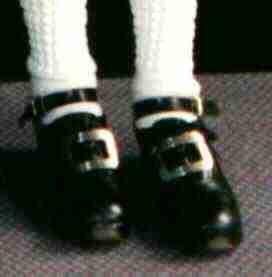
|
For the latest information where to buy Irish Dancing Shoes click here
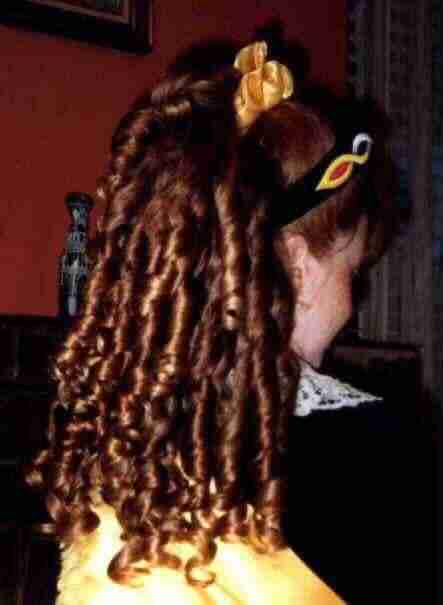
Except for those lucky girls with naturally curly hair, the hair is curled with curlers or rags etc. The Hair is done `half up half downí with a matching scrunchie or ribbon around the top pony tail. There is also a trend to having the hair up. This is often used when your daughter's hair is too short to curl tightly and ends up with a woolly ball for a hair do. The hair can be scraped up to a bun but left curly, not combed. Often this style is worn with a small tiara. But check with your teacher before you rush out and buy a tiara for a beginner. Also there is a rule that says you can't wear prizes (sashes, medals or tiaras) so check that your head gear isn't going to upset anyone. The hair is set with setting mousse so that the curls will hold for 3 hours of dancing. Any mousse will do if it mentions "strong hold" on the label. If your daughter has fine hair use small rollers, thick hair use the larger rollers. Curling papers can be bought by the box from hairdressers and these will help protect the hair while itís curled. If your daughter can't sleep in rollers, try "Softspikes" available by mail order from California. You can order by E-Mail but pay by cheque Softspikes!

Most often the hair is dressed after you arrive at the competition venue. A hair slumber net can hold curls between dances. The hair can be left in the ringlets or teased out into a fluffy mass. When you hire or buy a dress they come with matching embroidered head bands or crowns. These are worn in front of the scrunchie. For the mothers of boys...wash it, dry it brush it and thank your lucky stars.
Boys
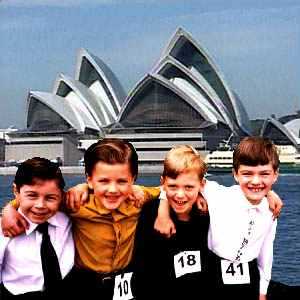
Why Irish dancing for your sons?
The competitions appeal to a boys sense of competitiveness, and they all seem to gain an incredible amout of self confidence as they master the dances, and perform in front of groups of people. Irish dancing is excellent for leg strength, fitness and coordination. (and of course they get to meet and dance with a multitude of pretty and talented girls!! - this may appeal to the slightly older boy) Seriously though, for the boys working with the girls in the teams and individual dances they gain a great deal of respect for each other abilities and talents.
Dancing is hard work (like footy training), requires a great deal of discipline to succeed (like the martial arts)and practice - like any sport or musical endeavour. Once the boys start working in team dances, Team spirit is very much in evidence (as much as any 'traditional' boys sport). For the boys involved in dancing, they need to have a strength of character (or guts) to do something that is not quite traditional in the Australian psyche.
Competition wear - no hair to curl!!!!, no expensive dress to fuss over - a relatively cheap sport for boys especially in the lower grades. As I stated earlier, boys now wear trousers and shirts. The days of kilts are over and only the truly confident wear them. (They look fabulous but it is the surest way to get a 13 year old to stop dancing)
© 2002 Amanda Finneran. Reproductions possible on request.

